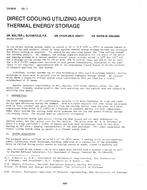The development of low-temperature (32 to 310 F, 0 to 150° C) phase change material (PCM) based systems for heating buildings began nearly four decades ago and just now is coming to fruition. After the “energy crunch” of a decade ago provided serious developmental impetus, progress was still impeded by unsatisfactory PCM behavior. As a result of diligent application of the basic PCM sciences — chemistry, thermochemistry, phase equilibria, crystallography, crystal growth, rheology, and heat transfer — a selection of stable PCMs is now available. The melting points span the temperature range from 45 to 243 F (7 to 117° C), matching the operating temperatures of most building heating and cooling systems.
Just as inattention to basics hampered the development of stable PCMs, progress toward the commercial availability of encapsulated PCM products has been restrained because of instances where the principles of good encapsulation technology were disregarded. In the last few years, some durable, well engineered, encapsulated PCM products have come do the market.
Units: Dual
Citation: Symposium, ASHRAE Transactions, 1985, vol. 91, pt. 2B, Honolulu, HI
Product Details
- Published:
- 1985
- Number of Pages:
- 14
- File Size:
- 1 file , 1.6 MB
- Product Code(s):
- D-HI-85-38-1


